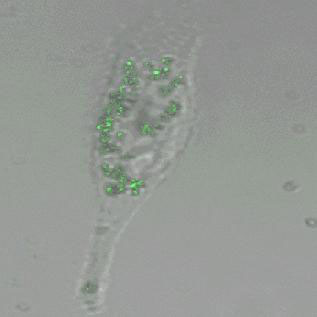| Posted: Apr 09, 2010 | |
Surface modification of silver nanoparticles and their interactions with living cells |
|
| (Nanowerk Spotlight) Silver nanoparticles can now be found in all kinds of products, from socks to food containers to coatings for medical devices. Valued for its infection-fighting, antimicrobial properties, silver, in its modern incarnation as silver nanoparticles, has become the promising antimicrobial material in a variety of applications because the nanoparticles can damage bacterial cells. Due to their plasmonic properties and easy surface chemistry silver nanoparticles are also beginning to attract interest among nanomedicine researchers. | |
| "The surface chemistry of nanoparticles that governs their interactions with other constituents in their environment has critical importance," Mustafa Culha, an associate professor who leads the Nanobiotechnology Group at Yeditepe University in Istanbul, Turkey, explains to Nanowerk. "Therefore, chemically altering the surface properties of nanoparticles with polymers, biological ligands and macromolecules is actively being explored. With the surface modifications, improvement in targeting and enhancement in cellular uptake are also achieved." | |
| Noble metal nanoparticles such as gold nanoparticles and silver nanoparticles have previously been modified with numerous ligands including oligonucleotides, carbohydrates and peptides for various applications. So far, though, there has not been any reported work using silver nanoparticles and functionalized silver nanoparticles for therapeutic applications. | |
| Culha notes that this is mostly due to the fact that the silver nanoparticles are considered toxic for eukaryotic cells. However, their wound healing properties have been known for many centuries. "We wanted to demonstrate the possibility of employing silver nanoparticles for therapeutic applications and, if they are toxic, reduce the toxicity though the surface modifications." | |
 |
|
| Confocal microscopy image of lactose modified silver nanoparticles in an A549 cancer cell. (Image: Dr. Culha, Yeditepe University) | |
| In a recent study ("Interaction of multi-functional silver nanoparticles with living cells "), Culha and his team have demonstrated that the functionalization of noble metal nanoparticles with multi-ligands can be used for cellular targeting. They further demonstrated that the toxicity of silver nanoparticles can be reduced by chemical modification, and they showed the possibility of using lactose-modified silver nanoparticles for selective targeting of eukaryotic cells. | |
| "This provides the opportunity to develop silver nanoparticle-based therapeutics for multi-purposes and imaging tools" says Culha. "The silver nanoparticles are plasmonic structures and they absorb and scatter a portion of the impinging light. While scattered light can be used for imaging, the absorbed light can be used for thermal killing of cancer cells after their selective uptake into the cancer cells." | |
| There are three main findings from the study by the Turkish team: 1) Biomacromolecules such as carbohydrates and oligonucleotides can be simultaneously attached to nanoparticles to achieve multifunctionality such as selective targeting of different types of cells; 2) Attaching the right ligands to the nanoparticles can help reduce the cytotoxicity of the nanoparticles; and 3) Although further in vivo studies have to be conducted, in vitro preliminary results indicate that carbohydrate based ligands can be used for selective targeting of cancer cells either with thermal therapy or delivering/silencing. | |
| For their experiments, the researchers exposed L929 and A549 cancer cells to both naked and modified silver nanoparticles. "We found that the cellular uptake and cytotoxicity of glucose- or lactose-modified silver nanoparticles were almost at the same level in L929 cells while the levels in A549 cells are rather different" says Culha. "Our results indicate that the use of carbohydrates significantly enhances the cellular uptake of silver nanoparticles into A549 cells. The lactose-modified silver nanoparticles entered the A549 cells at a faster rate. In addition, we observed that the first five hours are important for the cellular uptake of nanoparticles and the nanoparticles were mostly seen localized in the cytoplasm. The cytotoxicity study revealed the presence of glucose, lactose and oligonucleotide or their combinations on the nanoparticle surface might help to diminish the toxicity." | |
| This study suggests that careful evaluation of modified silver nanoparticles may provide new tools that can be used in novel applications in clinical cancer diagnosis and treatment, and other therapeutic applications, in particular: Selective targeting of cancer cells, possible gene silencing through the oligonucleotides attached to silver nanoparticles, heat based killing targeted cell (photo-thermal therapy), cellular and biomedical imaging. | |
 By
Michael
Berger
– Michael is author of three books by the Royal Society of Chemistry:
Nano-Society: Pushing the Boundaries of Technology,
Nanotechnology: The Future is Tiny, and
Nanoengineering: The Skills and Tools Making Technology Invisible
Copyright ©
Nanowerk LLC
By
Michael
Berger
– Michael is author of three books by the Royal Society of Chemistry:
Nano-Society: Pushing the Boundaries of Technology,
Nanotechnology: The Future is Tiny, and
Nanoengineering: The Skills and Tools Making Technology Invisible
Copyright ©
Nanowerk LLC
|
|
|
Become a Spotlight guest author! Join our large and growing group of guest contributors. Have you just published a scientific paper or have other exciting developments to share with the nanotechnology community? Here is how to publish on nanowerk.com. |
|
